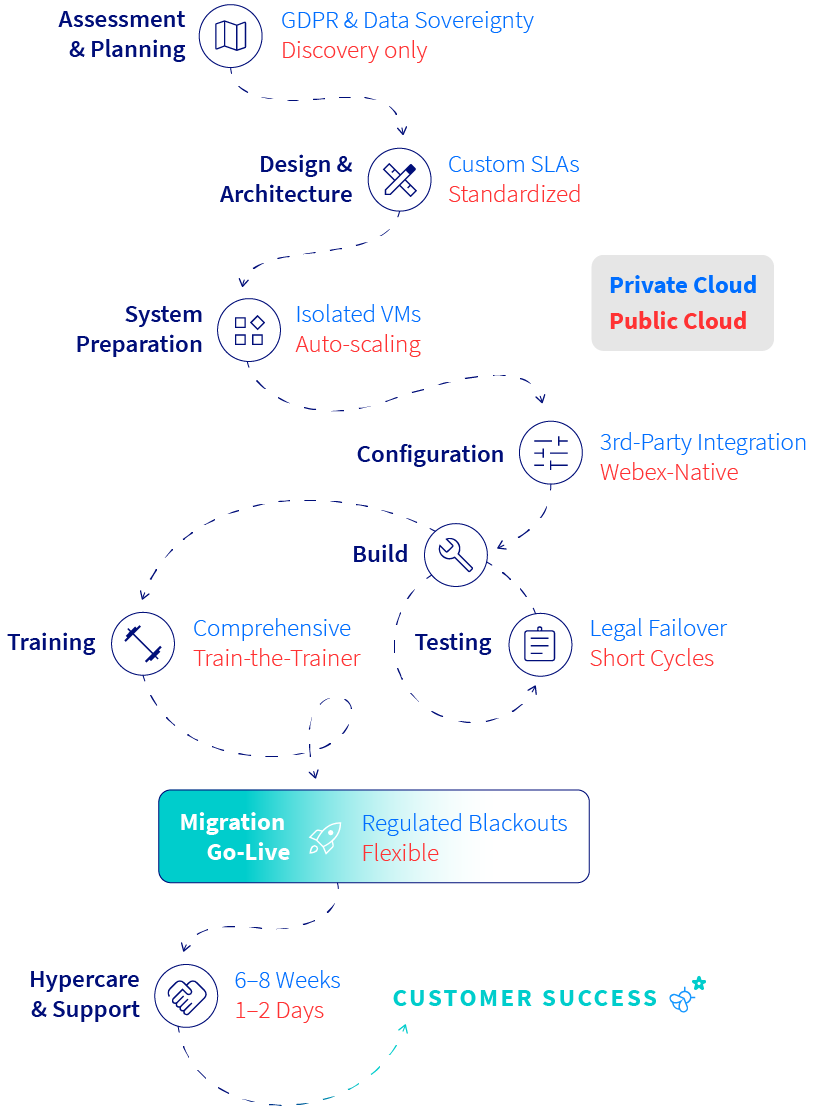If you plan to change your cloud strategy, you’re in good company. In a recent Rackspace survey, 90% of global tech leaders said they plan to do so over the next two years. Twenty percent said they plan to increase private cloud investments, while 24% plan to accelerate public cloud adoption.
Embedded somewhere in this field is a cohort of contact center professionals. They’re making plans in the shadow of a large elephant in the room:
Migrating the contact center from on-premises to the cloud.
Migrating your contact center from on-premises to cloud has many benefits. Doing so can improve cost efficiency, security, and scalability. It can support better business continuity, while reducing IT maintenance burden.
Let’s not forget about AI. For the 47% of tech leaders planning to integrate cloud-native AI and machine learning services (Rackspace), moving toward cloud solutions is becoming increasingly important.
The question is, is your contact center ready to make the change?
Start with a Migration Readiness Assessment
Migration to cloud requires careful planning, particularly for regulated industries. That’s why we always begin with a comprehensive assessment of your current contact center ecosystem.
| Assessment Area | Scope + Example |
|---|---|
|
Security and |
Thorough evaluation of your industry-specific regulations, data protection needs, and security protocols to protect compliance posture. Example: Healthcare provider needs HIPAA compliance, requiring end-to-end encryption for patient conversations and secure authentication for remote agents. |
|
Infrastructure and technical compatibility |
Detailed inventory and assessment of existing systems, software, integration points, and legacy applications to determine migration complexity. Example: A financial firm with a 15-year-old CRM needs custom APIs to ensure seamless data transfer to the new cloud platform. |
|
Operational workflows and user experience |
Analysis of agent workflows, customer journeys, and operational processes to ensure cloud adoption enhances current practices. Example: An e-commerce retailer preserves VIP escalation processes in the cloud, maintaining historical context across all channels. |
|
Cost-benefit analysis |
Comprehensive review of total cost of ownership comparing current expenses to projected cloud costs including maintenance and IT resourcing. Example: A telecom firm finds $450k in hardware upgrades can be avoided and realizes 22% savings over 5 years with predictable cloud costs. |
|
Business continuity planning |
Review of disaster recovery, uptime needs, and failover strategies. Example: A utility provider in storm-prone regions uses cloud redundancy across three data centers to maintain service during infrastructure outages. |
Public, Private, or Hybrid Cloud?
In a Public Cloud environment, you access computing services over the public internet. Your public cloud provider likely provides this access to multiple clients at the same time.
- Advantage: No capital expenditure on infrastructure; pay-as-you-go pricing that enables rapid scalability.
- Examples:
- Salesforce (although through Government Cloud – private cloud instances are available)
- Amazon Web Services (AWS) EC2 and S3
- Google Cloud Platform Compute Engine
- Webex Contact Center
In a Private Cloud environment, your cloud computing resources remain exclusive to your organization. They may be hosted on-premises or by a third-party provider (like Bucher + Suter’s Private Cloud Data Centers in Switzerland).
- Advantage: Better security and control for data and compliance-critical workloads; comprehensive oversight of where and how your data is stored.
- Examples:
- VMware vSphere/vCenter
- Microsoft Azure Stack
- Oracle Private Cloud Appliance
In a Hybrid Cloud environment, you’re orchestrating some combination of public, private, and on-premises infrastructure (private cloud for sensitive ops, for example; public cloud for variable workloads and customer-facing applications).
- Advantage: More flexibility overall
- Examples:
- AWS Outposts
- Google Anthos
- Cisco Intersight Workload Optimizer
Take a Strategic Approach to Cloud Migration
- Migration methodologies: Lift-and-shift, hybrid, phased, or complete transformation (could be a comparison table)
- Detailed migration roadmap with clear milestones (example graphic sourced or bespoke)
- Contingency plans and rollback options (real-world examples of what that might look like in contact center)

Case Study: SBK Elevates Customer Service with Bucher + Suter’s Private Cloud
Siemens Betriebskrankenkasse (SBK), one of Germany’s largest corporate health insurance funds, needed to modernize its communication systems to meet evolving customer expectations and regulatory requirements. With thousands of users across telephony, contact center, and collaboration tools, SBK sought a future-proof solution that would improve accessibility, reduce handling times, and strengthen data security.
Key Challenges
- Unified communication for 2,100+ users
- Complex integration of CRM, Finesse, and internal tools
- High standards for data protection and compliance (GDPR, SGB)
- Zero disruption to service during rollout
Migration Approach
SBK partnered with Bucher + Suter to deploy a fully integrated contact center via the b+s Private Cloud. The entire project, spanning 94 locations, was delivered remotely over 17 months during the pandemic, leveraging strong collaboration and meticulous planning.
Implementation Solution
Bucher + Suter implemented a comprehensive cloud collaboration and contact center solution featuring:
- Secure, privately hosted cloud contact center
- Seamless CRM integration and personalized agent desktop
- Enhanced monitoring, routing, and accessibility features
- Standardized telephony and collaboration platform across all locations
SBK’s Results
SBK achieved faster response times, improved agent efficiency, and reduced customer wait times, whilst meeting stringent data privacy requirements. The platform now supports scalable innovation, including future phases for chat, bots, and quality management.
Common Cloud Migration Pitfalls
Different phases of a cloud migration can quickly become moving targets, especially for larger-scale migrations. That’s why taking a strategic approach is so important; with sufficient planning, you can avoid a lot of headaches.
Application migrations: Deciding which applications will come over during migration, and which you’ll leave behind, is just the beginning. Especially for enterprise contact center migrations, application migration is critical. Amazon recommends the 7 Rs:

Cost overruns: The prevalence of cloud data storage issues is well documented (and widespread). Data transfer alone can be a lot more costly than most organizations anticipate, as are application migration and downtime.
Security issues: Improper configuration during migration can create vulnerabilities. Many organizations underestimate the shared responsibility model, assuming cloud providers handle security. In reality, businesses remain accountable for data protection, access management, and compliance.
Skills gaps: Organizations often underestimate the learning curve and specialized knowledge needed to implement and make use of cloud architecture. Do you need to go as far as building a Cloud Center of Execellence, as Amazon recommends? Maybe, maybe not. But plan to invest in staff upskilling for better adoption, at least, if not contracted cloud specialists.
Governance: Without a proper governance framework in place, your migration may give way to shadow IT, duplicated services, and general difficulty tracking costs. Here is where potential security risks may arise, too. Focus on building clear policies for resource provisioning, monitoring, and lifecycle management—before the migration begins.
Case Study: Leading Swiss Bank’s Successful Cloud Migration
Thurgauer Kantonalbank (TKB), a leading Swiss regional bank with 29 branches and over 800 employees, needed to modernize their aging on-premises contact center solution that had been in place for over 20 years. As a financial institution, they faced strict regulatory requirements while needing to enhance customer experience and operational efficiency.
Key Challenges
- Maintaining compliance with Swiss banking regulations
- Ensuring business continuity during migration with zero service interruptions
- Integrating with existing systems, including their core banking platform
- Managing the cultural transition from legacy systems to cloud-based operations
Migration Approach
TKB partnered with Bucher + Suter to conduct a meticulous planning process that included comprehensive risk assessment, detailed technical evaluations, and careful testing protocols. The migration followed a phased approach, allowing for verification at each step and minimizing disruption to daily operations.
Implementation Solution
Bucher + Suter implemented a private cloud solution specifically designed for TKB’s needs, featuring:
- Deployment across two high-security data centers in the Bucher + Suter private cloud (compliance and system resilience)
- Customer experience enhancements including advanced routing capabilities and omnichannel support
- Modern agent workspace tools that improved efficiency while maintaining familiarity for staff
- Sophisticated integration with existing banking systems through secure APIs
TKB’s Results
The migration delivered significant improvements in operational efficiency, enhanced customer experience capabilities, and reduced IT maintenance burden. In the end, TKB achieved the benefits of cloud technology without compromising on their regulatory requirements or system reliability.
Navigate Cloud Migration with a Trusted Partner
Our case studies make one point clear: the shift from on-premises to cloud is more than a technology upgrade—it’s a strategic transformation with many moving parts. Assessment and strategy remain critical to successful migrations. The more thorough and comprehensive, the better.
STAY UP TO DATE
Recommended reading: Guide to Contact Center as a Service (CCaaS)
At Bucher + Suter, we’ve guided dozens of organizations through this exact journey. We offer versatile migration options suitable for even the most highly regulated industries, such as finance and healthcare. Connect with us today to take the first step.





